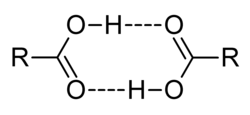About to di(mer)
 Suppose a molecule
Y
, carboxylic acid for instance, can form dimers
Y
:
Y
denoted as
Y
2
. The forward reaction between two molecules of
Y
to form a dimer has rate constant
k
f
=
5
×
1
0
−
5
mM
−
2
s
−
1
, and the backward reaction of one dimer breaking into two monomers has rate constant
k
b
=
2
mM
−
1
s
−
1
.
Suppose a molecule
Y
, carboxylic acid for instance, can form dimers
Y
:
Y
denoted as
Y
2
. The forward reaction between two molecules of
Y
to form a dimer has rate constant
k
f
=
5
×
1
0
−
5
mM
−
2
s
−
1
, and the backward reaction of one dimer breaking into two monomers has rate constant
k
b
=
2
mM
−
1
s
−
1
.
You prepare a solution of 1 0 0 mM Y , what is the equilibrium concentration (in mM ) of the dimer Y 2 ?
The answer is 0.247531.
This section requires Javascript.
You are seeing this because something didn't load right. We suggest you, (a) try
refreshing the page, (b) enabling javascript if it is disabled on your browser and,
finally, (c)
loading the
non-javascript version of this page
. We're sorry about the hassle.
2 solutions
But I think my solution was wrong. [ Y ] is not equal to 1 0 0 m M but ( 1 0 0 − x ) m M .
Let the concentration of dimer at equilibrium be x m M . This implies that concentration of monomer would be ( 1 0 0 − 2 x ) m M , because 2 molecules of monomers give one dimer. Now equate the rates of reactions to get the equation 5 × 1 0 − 5 ( 1 0 0 − 2 x ) 2 = 2 x . Solve the quadratic to get the answer 0 . 2 4 7 5 3 .
Seriously, we have to solve the quadratic? Why can't I approx it and take 1 0 0 − 2 x as 1 0 0 only?
Log in to reply
Simply due to the fact that the extent of dimerization(of the acid) is non-negligible and needs to be. Evaluated For better accuracy
I have got perfect 0 . 2 5 m M as answer.
The law of mass action gives that for a reversible reaction 2 Y ⇌ Y 2 ,
the forward reaction rate = k f [ Y ] 2
the backward reaction rate = k b [ Y 2 ]
where [ Y ] and [ Y 2 ] are the concentrations of Y and Y 2 respectively.
At equilibrium, the forward and back reaction rates are equal, therefore,
k f [ Y ] 2 = k b [ Y 2 ] ⟹ [ Y 2 ] = k b k f [ Y ] 2 = 2 5 × 1 0 − 5 × 1 0 0 2 = 0 . 2 5